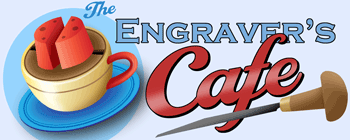Since the engraving world has shifted to horizontal engraving with microscopes etc., There will be, I am afraid, a need to adjust the posture aspects, unless you mount your vice, scope, etc. very low. Most benches don't allow for this, unless you have adaptors etc. GRS has tried to accomodate this need, but something I see, and this only would apply to one who is an all around engraver (One who engraves on anything and everything), The scope sets up a situation I think, that would be very tiring without something to get you arm and wrist in a straight line and there is a lot of stuff that gets in your way.
Working with conventional tools and methods, (old ways) you tilt the vise to get your arm and wrist in line. Then the rotation of the vise will allow you to make smooth turns and circles without strain as you turn the vise into your tool, rather than work your wrist to make the curve. If the wrist is in a forced position, making smooth curves becomes more difficult, plus the strain after long hours at the bench will begin to tell on you.
It will show up in all kinds of places, as your body is not in a natural position. Stress causes tension. Tension causes lost hand eye co-ordination.
Now, the arm rest idea is a good one getting the elbow up for cutting on a horizontal plane (microscope), but stagnating movement a bit. It is pretty essential to include movement as the body was designed for motion, so shift your position and make your engraving area a bit adjustable so that you can do this. Just slight adjustments every little while will minimize the fatigue and tension and therefore pain.
An arm rest can be made simply by having a slot cut that a board will slide in and out of the bench with a pad to rest the elbow on (can be soft rubber or foam). It doesn't have to be complicated, and would be very easy to install on a bench that you are making yourself. You can slide the rest into the bench to get it out of the way.
It was a little easier to assume good posture when you were young and could see, but with magnification and very close tedious work of today's engravers, we have exasterbated good posture with magnification, and the need to be very still to see through the scope, at least that is my take on it. Am too old to change my ways I guess, but speed was extremely important in my day, and one couldn't afford to be putting obstacles in his way and he needed to be very fluid and flexible. Time is money. Every moment wasted was time lost on the project.
Just some thoughts that might help you get a bit more comfortable with less pain if there is any.
Ron S
Working with conventional tools and methods, (old ways) you tilt the vise to get your arm and wrist in line. Then the rotation of the vise will allow you to make smooth turns and circles without strain as you turn the vise into your tool, rather than work your wrist to make the curve. If the wrist is in a forced position, making smooth curves becomes more difficult, plus the strain after long hours at the bench will begin to tell on you.
It will show up in all kinds of places, as your body is not in a natural position. Stress causes tension. Tension causes lost hand eye co-ordination.
Now, the arm rest idea is a good one getting the elbow up for cutting on a horizontal plane (microscope), but stagnating movement a bit. It is pretty essential to include movement as the body was designed for motion, so shift your position and make your engraving area a bit adjustable so that you can do this. Just slight adjustments every little while will minimize the fatigue and tension and therefore pain.
An arm rest can be made simply by having a slot cut that a board will slide in and out of the bench with a pad to rest the elbow on (can be soft rubber or foam). It doesn't have to be complicated, and would be very easy to install on a bench that you are making yourself. You can slide the rest into the bench to get it out of the way.
It was a little easier to assume good posture when you were young and could see, but with magnification and very close tedious work of today's engravers, we have exasterbated good posture with magnification, and the need to be very still to see through the scope, at least that is my take on it. Am too old to change my ways I guess, but speed was extremely important in my day, and one couldn't afford to be putting obstacles in his way and he needed to be very fluid and flexible. Time is money. Every moment wasted was time lost on the project.
Just some thoughts that might help you get a bit more comfortable with less pain if there is any.
Ron S






